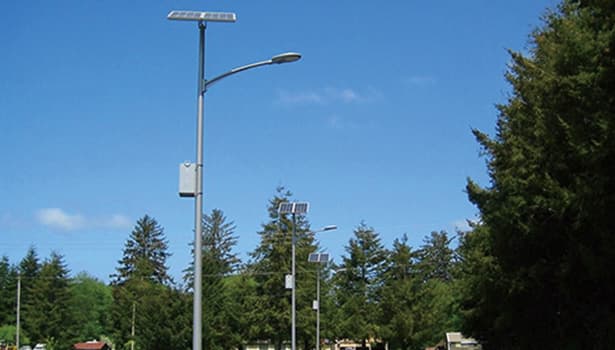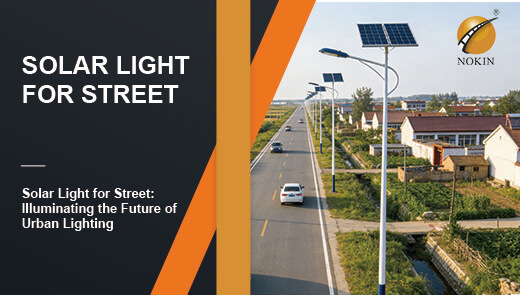How to Use Solar Street Lights in Summer
In summer, solar street lights enter the golden age of energy - with such generous sunlight, can we just rest easy? Theoretically, at this point, the photovoltaic modules are sufficient to capture enough light energy, allowing the street lights to emit the brightest light in the dark.
Reality, however, conceals many hidden reefs. The continuous high temperature is like an invisible oven, and the sudden rain and strong wind are like uninvited destroyers. Moreover, the lush trees in summer are quietly covering the photovoltaic panels. These unique challenges of summer can easily reduce the performance of solar street lights if one is not careful. So how can solar street lights safely get through each summer? Next, Nokin is going to share with you those little tips hidden in the details. Let's take a look together!

How Do Solar Street Lights Make Efficient Use of Sunlight?
Let the Sunshine Flow Freely
The "appetite" of photovoltaic modules depends entirely on whether there is enough sunlight. The obscured solar panels are like people with their mouths covered - how could they possibly be full? You may not have noticed it during the day, but if the solar street lights suddenly go out at night, you might need to consider whether the power generation is insufficient.
Prune the branches regularly
Summer is a season full of vitality. All the green plants grow very fast during this season. If the branches and leaves quietly climb up the solar panels, the shadows will spread like ink stains, swallowing up the precious light energy. Look up regularly. Those overly arrogant branches should be pruned without hesitation. Isn't the importance of choosing the right installation location for solar street lights particularly clear at this moment?
Avoid the shadows of buildings
The shadows of the buildings are even more stubborn. If you choose to install solar street lights beside high-rise buildings for the sake of convenience, you will have to endure the predicament of insufficient photovoltaic panels throughout the summer. Isn't the importance of choosing the right position particularly clear at this moment?
Take into account the impact of continuous rainy days
The variability of summer weather can be said to exceed your imagination. When it rains continuously, even the sunlight has to "squeeze" through the clouds. When the sky is clear and blue, strong light may cause the components to "indigestion". Only by observing the local weather conditions in summer can we find the most comfortable Angle and position for the photovoltaic panels.
Adjust the Angle of the Photovoltaic Panels
The tilt Angle is the key. In the summer of the Northern Hemisphere, it is advisable to adjust the Angle of photovoltaic panels a little to catch more slanting sunlight. How much exactly? It is still necessary to refer to the local dimensions. The higher the latitude of the place, the more attention should be paid to the extent of bending. If you don't know how to calculate, you can consult a photovoltaic engineer to get a more accurate value.
We definitely can't adjust the Angle of the solar panels every day. So let's aim for the midday sun! At this moment, it stands the highest, with the most intense light. Its face is aligned with it, and at least it can grasp the most abundant energy of the day. In the Northern Hemisphere, the midday sun is usually in the south. Therefore, it is always right for solar panels to face south.
Details of Solar Street Light Maintenance
Maintenance of Batteries and Circuits
High temperature acts like an invisible aging accelerator. Under its baking, batteries and circuits are quietly undergoing changes. Have you ever seen a battery with swollen cells? That's no small matter!
A monthly inspection is indispensable. During the inspection process, it is important to pay close attention to whether the battery casing is bulging. Has the insulation layer of the line cracked? These details conceal potential safety hazards. Once any abnormality is detected, don't hesitate to replace it immediately. Don't wait until a small problem turns into a big trouble. By then, it will not only affect the use of solar street lights but also increase additional costs, which is not worth it.
The battery terminals also need care. In the humid air of summer, rust is spreading secretly. When maintaining these small components in solar street lights, wipe the battery terminals with a dry cloth and then apply some Vaseline. This protective film can keep the conductivity always online. Don't underestimate these few simple steps; they can save you a lot of trouble later on.
Choose the Right Battery
Which is more suitable for solar street lights in summer, lithium batteries or gel lead-acid batteries?
Lithium batteries perform outstandingly in summer and can still maintain stable output in high temperatures. It has a high energy density and an excellent charging and discharging efficiency. The more sunlight there is in summer, the more it can exert its advantages. The cycle life is beyond reproach. It can be used for five or six years without any problem.
Gel lead-acid batteries are slightly lacking. Continuous high temperatures will accelerate the shrinkage of its capacity and also reduce its lifespan. Its energy density is already inferior to that of lithium batteries, and its performance in summer pales in comparison. Who to choose? The answer is already quite obvious, isn't it?
Enhance Ventilation and Heat Dissipation
Did you know? In an environment above 35℃, the battery life of solar street lights may be "halved"! High temperatures accelerate internal chemical reactions, causing capacity to decrease day by day and the charging and discharging efficiency to decline as well - the situation of sudden lights going out at night may occur at any time.
The key point of maintaining solar street lights in summer is ventilation! The importance of ventilation and heat dissipation surely needs no further elaboration. Open a few ventilation holes on the battery box to allow air to circulate and the temperature will naturally drop. When choosing batteries, pay attention to the heat dissipation design. Those models with heat dissipation fins are saviors in hot weather. When installing, keep a distance from the heat-generating components. Distance not only creates beauty but also safety.

Solar Street Lights are Well-Suited to the Environment
The selection of the Installation Location for Solar Street Lights
If you choose the right place, the service life of solar street lights can be extended by several years. How important is a location with abundant sunlight throughout the day? Take a look at those street lights shaded by trees, the way they "go on strike" when it gets dark, and you'll understand.
It should be very difficult to ensure that photovoltaic panels receive sunlight throughout the day. However, by choosing the right prime location, it is possible for solar photovoltaic panels to receive the maximum amount of sunlight. When selecting the installation location for solar street lights, it is essential to take into account the local actual situation!
Avoid possible obstructions. Not only should tall trees and buildings be taken into account, but also utility poles and billboards. The larger the area and the longer the duration of the shadow projected onto the photovoltaic panels, the less power generation the panels will generate, which will then affect the luminous duration and brightness of the solar street lights!
Another thing is that the Angle of the sun changes in summer. Objects that did not block light yesterday may become stumbling blocks today. Before installing solar street lights, it is advisable to wait and observe for a few days, measure the trajectory of sunlight with your feet, choose the most suitable position for the solar street lights, and select the most accurate Angle for the photovoltaic panels. Once they are put into use and you look at the bright solar street lights, you will know that the effort has been well spent.
Take into full account the weather characteristics of summer
The most notable feature of summer is high temperature, humidity and heavy rain, each of which is a fatal blow to solar street lights.
Heavy rain is coming at any time. If water gets into the battery box, the consequences would be unimaginable. Only when the seal is well done can one rest easy. After the rain, open the box cover and check. If there is any accumulated water, clear it up immediately. Under no circumstances should the battery be submerged in water. The consequences would be unimaginable.
Don't be careless even on windy days. It's no joke that a blown branch hit the pole of a solar street light. When choosing the installation location for solar street lights, select a sheltered corner and regularly check the fixing screws. The tighter they are tightened, the safer it is.
When the scorching sun is high in the sky, light posts and lightshades are also suffering. Therefore, it can be considered to apply a layer of sun-protective coating to the light poles and lightshades of solar street lights, giving them a "sun-protective coat", which can significantly slow down the aging process. These small details hold the secret to extending the lifespan of solar street lights.
Formulate A Maintenance Plan for Solar Street Lights
The dust on the photovoltaic panels is like putting a mask on them. There is a lot of dust in summer. Wiping it once a week is not much. The cleaning methods of solar street lights have been mentioned many times in our previous blogs. You can use a soft cloth dipped in water to gently wipe them. Do not scrape them with hard objects. That layer of coating is the key to energy absorption.
Regularly check the growth of the surrounding trees. The speed of plant growth will surprise you in summer. The shrubs that were short last week might be taller than the light posts this week. Prune them once a month. Don't let them steal the limelight from the sun.
If you have dedicated maintenance personnel, you can make a schedule for the maintenance of solar street lights, but it also needs to be flexibly adjusted according to the weather. If it's not convenient or you find it troublesome, you can record the time of each cleaning, inspection and pruning in your phone's memo. Scientific and reasonable maintenance is the key to extending the service life of solar street lights!




